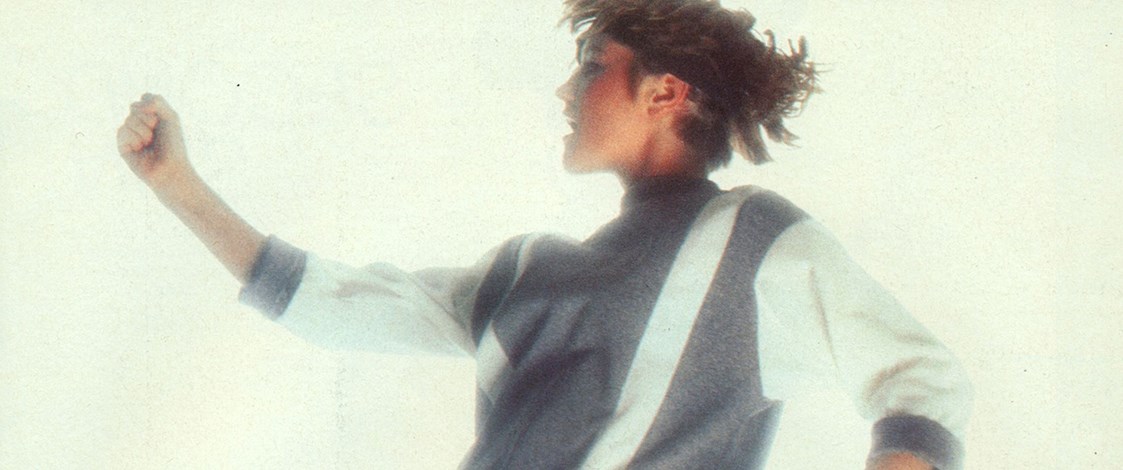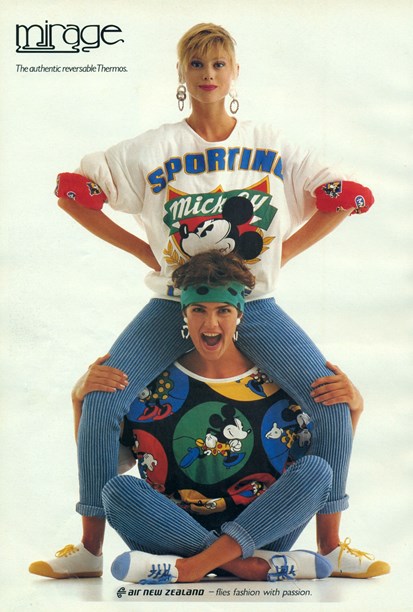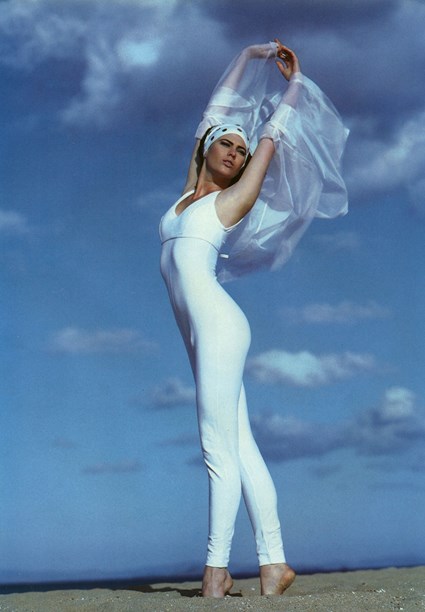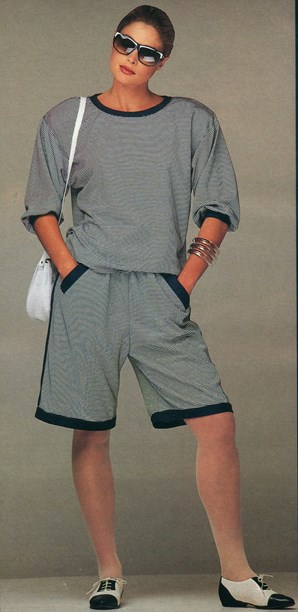Stories
Fitness & Fashion
1980s

The call for women to slim down and tone up in the 1980s led to an obsession with body-shaping and physical fitness. Inspired by Olivia Newton-John’s Let’s Get Physical video, movies like Flashdance and Perfect, in which Jamie Lee Curtis played an aerobics instructor, and Jane Fonda’s Workout Book (31 weeks on the New York Times bestseller-list), New Zealand women flocked in droves to aerobics and dance classes, workout centres and health clubs.
Clothes for working-out became an extremely profitable part of the garment industry. It wasn’t long before fitness and fashion fused and leotards, legwarmers, leggings, warm-up suits, sweatshirts and headbands migrated from the gym to the street.

1987 advertisement for Mirage, an active-wear brand whose ranges included cotton-knit sweatshirts with power prints, crop tops, shorts and knee-length singlet dresses and t-shirts.
Leggings and legwarmers, long woollen footless socks designed to maintain body heat before, during and after exercising, emerged as fashion items. Zambesi paired leggings with short dresses and hoop skirts, Sonny Knitwear, Hero and Jag with over-sized slouchy jumpers, comfort incarnate. Outside the gym, legwarmers were worn over pants and leggings or tucked into boots.
As the fitness craze accelerated, the leotard, once the preserve of ballet dancers and acrobats, acquired fashion status. Swimsuit manufacturers such as Moontide, Expozay and Sea Folly began making leotards as well as swimwear, both of which they cut more provocatively to show off the body-beautiful. John Armstrong, then owner of trendy Auckland swimwear shop Blue Dude, says leotards and exercise-wear accounted for much of his turnover while the fitness trend lasted. He remembers only one style that met with resistance, the G-string leotard, which he says went a step too far. "It wasn’t popular. Women didn’t go for it at all."
Expozay’s advertising in the 1980s highlighted the connection between physical exercise and a swimsuit-perfect body.
In the hands of New York designer Donna Karan, the body-hugging leotard morphed into the form-fitting bodysuit which she called 'the modern girdle'. Designed to be worn, in lieu of tuck-in tops under other garments, it soon proved its versatility. Sleeveless, long or short sleeved, it came in different style variations and could go from day to night with the change of a jacket, skirt, pants or jewellery. In New Zealand, the bodysuit trend was taken up enthusiastically across the board. While Expozay, Moontide, Pazazz and other swimsuit companies went for a sportive look, fashion designers like Rosaria Hall using sequins, SooKim using neoprene, and Doris de Pont working with stretch vinyl, created bodysuits suitable for club-wear.

Zambesi full-length cotton Lycra bodysuit and hooded organza coat. Fashion Quarterly, Summer 1989.
Innovation was encouraged by the manufacturers of Lycra and in 1982 the Du Pont Lycra Student Fashion Design Awards were set up. Fashion students were invited to create body-wear and swimwear, using Du Pont fabrics. These were judged by a panel from the garment industry and presented in a catwalk show. Over the years, the entry rate remained consistently high.
The fitted tank top, a crotchless variant of the leotard, was another quick-change garment. To demonstrate its diversity, Fashion Quarterly invited eight fashionable women to style a white cotton Lycra tank top with other pieces in their wardrobes. Their choices included jeans, a beaded jacket and short silk skirt, a long evening skirt worn with a cropped denim jacket tied at the waist and a classic tailored suit.
Sportscraft, Thornton Hall, Puritan, Peppertree Sport, Vamp and Earlybird were among those to incorporate elements of exercise-wear – singlet dresses, baggy tops, loose-legged longer shorts, cropped tops and bike pants – in their casual co-ordinates ranges, effectively bridging the gap between active sportswear and dressy daywear. It was very much a case of this goes with that and that goes with this. Entire collections were built around the co-ordinates concept.

Vamp stretch top and matching cycle pants. Fashion Quarterly, Summer 1988.
The Zainy boutique in Auckland’s Ponsonby Road, was one of a number of small establishments producing their own sportswear-inspired designs. Specialising in co-ordinated pieces and accessories in cotton knit fabrics like double knit jersey, rugby, sweatshirting and fleece (brush backed sweatshirting), it had a lively, informal atmosphere that attracted a predominantly young clientele. Owner/designer Denise Campbell later went to work for Moontide.

Cotton-knit makes the transition from gym to street in a horizontally striped top with padded shoulders and long, loose-fitting shorts by Puritan. Summer collection 1987.
Sweatshirting, which skyrocketed to fame when nonconformist American designer Norma Kamali used it in her collections, also established itself here as a top casualwear fabric. Not that everyone approved. Discussing the merits of this material for an article in Fashion Quarterly, Thornton Hall’s Isabel Harris cited the fabric’s comfort, easy fit and easy care while Keith Matheson and Suzanne Gregory’s Debbie Cook didn’t think it worth getting excited about. In their opinion, it should have been confined to the sweatshirts and sweatpants for which it was intended.
Teamed with a pair of designer trainers, sweatshirts and sweatpants (aka tracksuits) became the uniform for an early morning jog, school drop-offs or informal socialising. By offering a wider choice of colours and adding subtle design details, Jantzen, Adidas, Ton Sur Ton, Lane Walker Rudkin and other active-wear manufacturers transformed what were traditionally sports garments into fashion co-ordinates with an urban edge.
The excesses of the 80s are long gone but the influence of the fitness phenomenon on mainstream fashion is currently staging a comeback. Today the trend has been ascribed terms like 'sportivity' and 'athluxury' denoting the influence of designer fashion on sportswear brands, with the likes of Stella McCartney and Yohji Yamamoto designing for Adidas. In recent seasons, it has become a two-way exchange with a number of high-fashion ready-to-wear collections striving to look dynamic, active and athletic. Combining sport, fashion and a healthy lifestyle is modern.
While Lycra bodysuits and legwarmers have failed to make a reappearance, track pants and jackets, shell suits, ski jackets and sweatshirting are back in the fashion arena. At New Zealand Fashion Week in August 2017, the Zambesi collection included track pants with side stripes, jumpsuits and sweatshirts printed with the slogan 'nEVER GIVE Up', a fitting sentiment for a trend that shows no sign of dying.
Text by Cecilie Geary. Banner image 1988 advertisement for Jantzen Sport warm-up suit in cotton fleece sweatshirting.
Last published September 2017.